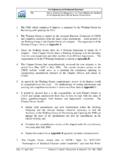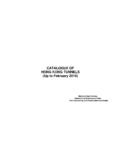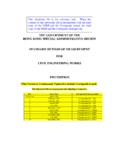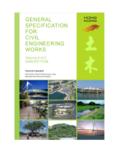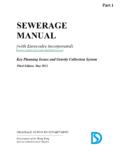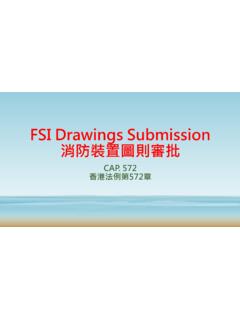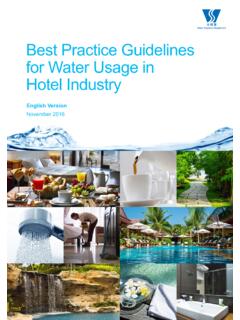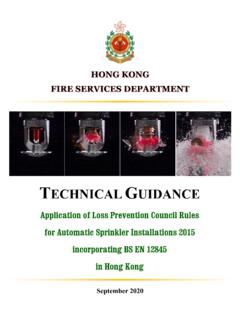Transcription of Guide to Trench Excavations (Shoring Support and Drainage ...
1 Guide TO Trench Excavations (SHORING Support AND Drainage MEASURES) Utilities Technical Liaison Committee HIGHWAYS department and Geotechnical Engineering Office CIVIL ENGINEERING department THE GOVERNMENT OF THE HONG KONG SPECIAL ADMINISTRATIVE REGION February 2003 Guide TO Trench Excavations (SHORING Support AND Drainage MEASURES) Utilities Technical Liaison Committee HIGHWAYS department and Geotechnical Engineering Office CIVIL ENGINEERING department THE GOVERNMENT OF THE HONG KONG SPECIAL ADMINISTRATIVE REGION February 2003 2 FOREWORD Trench Excavations are carried out principally to allow installation or repair of public utilities, drains and sewers to serve populated areas.
2 The Geotechnical Engineering Office (GEO) of the Civil Engineering department (CED) recently undertook a study on failures of Trench Excavations in Hong Kong. The study found that between 1986 and 2000, there were at least 10 deaths and 4 injuries caused by the failures of Trench Excavations . The study also found that a number of landslides resulting in significant social disruption in recent years were related to Trench Excavations adjacent to slopes. Therefore, the study concluded that the risk from Trench Excavations is not low and some improvement measures should be done to enhance the safety standards of Trench Excavations in Hong Kong.
3 The findings of the study with recommendations on enhancement of the safety of Trench Excavations were presented to the Standing Committee on Slope Safety (SCOSS) of Environment, Transport & Works Bureau (ETWB). It was decided by the SCOSS that a Working Group should be formed under the Utilities Technical Liaison Committee (UTLC) of Highways department to take the recommendations forward, including the preparation of a technical Guide to Trench Excavations , and GEO/CED should provide technical assistance to the UTLC to prepare the Guide .
4 The Working Group, composed of the major utility undertakings, representatives from Hong Kong Construction Association, the Association of Consulting Engineers of Hong Kong, Highways department , water supplies department , Drainage Services department and Labour department , in conjunction with GEO/CED prepared this Guide on good practice of shoring Support and Drainage measures for Trench Excavations . As part of the Government s continuing effort to promote a safe and healthy working environment, it is the intention of this Guide that the safety of the personnel involved in the works and also the general public who may be affected by Trench collapses or failures can be enhanced.
5 (C. K. WONG) Chairman Utilities Technical Liaison Committee Highways department February 2003 3 CONTENTS Page No. Title Page 1 FOREWORD 2 CONTENTS 3 INTRODUCTION 5 OBJECTIVE AND SCOPE 6 PLANNING STAGE 7 Desk Study 7 Timing and Location 7 Statutory Requirements 8 DESIGN STAGE 9 Temporary Support Design 9 Design Considerations 10 Loading 10 Drainage 10 Groundwater Control 11 Existing Man-Made Slope Features 11 CONSTRUCTION STAGE 12 Installation of Support 12 Special Drainage Provisions in the Wet Season 12 Backfilling of Trench and Reinstatement 13 Precaution in Use of Machinery 13 Other Considerations 14
6 4 SITE SUPERVISION AND SITE SAFETY INSPECTION 15 Site Supervision 15 Site Safety Inspection 16 Safety Checklist for Supervisors 16 Drainage Provisions 17 REFERENCES 19 APPENDIX A : TYPICAL ARRANGEMENT OF SHORING 21 DETAILS APPENDIX B: RECOMMENDED Drainage MEASURES 34 5 INTRODUCTION The Geotechnical Engineering Office (GEO) of the Civil Engineering department (CED) recently carried out a study on failures of Trench Excavations in Hong Kong. The study included a review of known past failures of Trench Excavations , and also the current technical standards and statutory requirements for Trench Excavations .
7 The study has revealed that, between 1986 and 2000, fifteen reported failures associated with Trench Excavations resulted in 10 deaths and 4 injuries. In a very serious single incident in 1966, a retaining wall collapsed killing 6 people and injuring 16 others. Trench excavation at the toe of the wall was found to be the main cause of the collapse. The study also found that a number of significant landslides in recent years, which resulted in injuries and serious social disruption, were related to Trench Excavations adjacent to slopes.
8 The details and findings of the study are documented in the Special Project Report SPR 2/2001, GEO (2001). The GEO/CED study concluded that the risk from Trench Excavations is not low. A Working Group was therefore formed under the Utilities Technical Liaison Committee (UTLC) of Highways department to prepare guidelines to promote safe practice for Trench Excavations . This document presents the recommendations of the Working Group as part of the Government s continuing effort to promote a safe and healthy working environment for all personnel in construction sites and others who may be affected by the works.
9 6 OBJECTIVE AND SCOPE Trench Excavations are carried out principally to allow installation or repair of public utilities, drains and sewers to serve populated areas. The purpose of this Guide is to provide recommendations on good practice of shoring Support and Drainage measures for Trench Excavations in order to enhance the safety of the people who may be affected by the excavation works or their collapses. Before a Trench is excavated, the designer should bear in mind that the Trench Support system and associated precautionary measures should be required to serve two purposes: (i) stability of the Trench itself, and (ii) avoidance of any adverse effect on the stability of adjacent slopes and in turn the safety of the public.
10 ( Slopes in this Guide should be taken to mean man-made slopes, retaining walls or sloping natural ground.) As determined by the GEO/CED study (GEO, 2001), the collapse of trenches is attributed to inadequate shoring, largely due to non-compliance with contract specifications and statutory requirements. However, one of the major contributory factors in the case of Trench -related slope failures was found to be inadequate Drainage provisions. In view of the above, this Guide emphasizes the deficiencies identified by the GEO/CED study, the need for adequate shoring Support and Drainage measures, and the need to comply strictly with site supervision requirements and site safety inspections.
